|
|
|
|
Archbishop Mor Julius Yeshu` Çiçek, who passed away on October 29, 2005 at the age of 63 is acknowledged as one of the greatest shepherds of the Universal Syrian Orthodox Church. Since his consecration as the first Metropolitan of Central Europe in 1979, His Eminence had oversaw the establishment of a number of churches and monasteries in Germany, Netherlands, Austria, Switzerland, Norway, Sweden, England and France. In the 1970s when Christians found it impossible to continue in their ancient homeland in South East Turkey and emigrated to Europe enmass, it was Mor Yulius Çiçek who shepherded the community in Europe. During the twenty-six years of his archbishopric, the Church in Europe achieved remarkable growth.
Mor Yulius made very significant scholarly contributions to the Church through the Bar Hebraeus Publishing House which published about 100 books related to the Syriac Orthodox liturgy, Bible, history, etc., in Syriac and in European languages, as well as periodicals such as the "Kolo Suryoyo". His Eminence was also an eminent calligrapher who continued the ancient Syriac Orthodox tradition of liturgical manuscript production as a monastic vocation.
Biography
Mor
Julius Yeshu` Çiçek was born on January 1, 1942 in Upper Kafro, in Tur `Abdin (Turkey), to Qashisho
Barsawmo and Bath-Qyomo
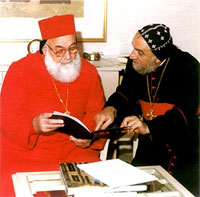 Sayde. At the age of
nine he went to seminary at
Deyr-ul-Za'faran, where he studied Syriac, Turkish, Arabic and Theology. He
was ordained a deacon in 1958, and became a secretary to the late Metropolitan
Mor Philoxenos Hanna Dolabani. Later he joined the monastery of Mor Cyriacus in
the region Bsheriye (Bitlis) to administer pastoral service and engaged in a
mission to seek Syriac and Armenian Christians, who survived the genocide of
1915 at the hands of the Turks.
Sayde. At the age of
nine he went to seminary at
Deyr-ul-Za'faran, where he studied Syriac, Turkish, Arabic and Theology. He
was ordained a deacon in 1958, and became a secretary to the late Metropolitan
Mor Philoxenos Hanna Dolabani. Later he joined the monastery of Mor Cyriacus in
the region Bsheriye (Bitlis) to administer pastoral service and engaged in a
mission to seek Syriac and Armenian Christians, who survived the genocide of
1915 at the hands of the Turks.
In 1960 he was made a novice monk in the monastery of Mor Gabriel and embraced an ascetic life. He taught in the theological seminary at Mor Gabriel and copied many books with an exellent hand. When Fr. Shabo Guenes, the abbot of the monastery retired in 1962, Fr. Yeshue Çiçek was chosen as abbot of the monastery. In 1969, Mor Iwannis Ephrem Bilgic, the Bishop of Tur `Abdin, ordained him a priest. Between 1973 and 1974, Yeshu` Çiçek lived in Damascus, in the Seminary of Mor Ephrem at Atshane in Lebanon and in the Holy land. Then he came to Germany, where learned the German language and ministered to the Syrians of the diaspora. At the request of the Metropolitan of America, Mor Athanasius Yeshue Samuel, Dayroyo Yeshu` Çiçek was in the United States from 1975-77, learning English and ministering to the Syriac Orthodox faithful there. In 1977, he returned to Europe and settled in Holland at Hengelo.
In the same year the Holy Synod chose him as the Patriarchal Vicar for the new diocese of Central Europe. He constructed a hall for a new Syriac Orthodox church of St. John the Evangelist, which was consecrated by the late Patriarch Mor Ignatius Ya`qub III. In 1978, Dayroyo Yeshu` began publishing Kolo Suryoyo, the news magazine of Syriac Orthodox diocese of Central Europe.
Archbishop who built the Church in Europe
On June 24, 1979 the Patriarch Ya`qub III consecrated
Dayroyo Yeshu` Çiçek in Hengelo as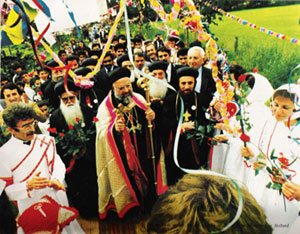 Archbishop of the Syrian Orthodox diocese of
Central Europe, with the name Mor Yulius. In 1984, Mor Julius acquired
Dayro d-Mor Ephrem at Losser, Netherlands, which became the seat of the
archbishop. Under the able guidance of His Eminence, the Central Europe diocese
has flourished.
Archbishop of the Syrian Orthodox diocese of
Central Europe, with the name Mor Yulius. In 1984, Mor Julius acquired
Dayro d-Mor Ephrem at Losser, Netherlands, which became the seat of the
archbishop. Under the able guidance of His Eminence, the Central Europe diocese
has flourished.
Due to his efforts, the Church now has three large monasteries in Europe--near
Enschede in the Netherlands, in Arth, Switzerland, and in Warburg, Germany.
Several parishes were formed throughout Europe--nearly 50 in Germany and several
others in the Netherlands, in Austria, Switzerland, Norway, Sweden, England and
France, among others. In the monasteries he founded, Mor Yulius established
monastic schools which trained the clergy and faithful in the new diaspora in
the traditions of the Church.
Contributions
Mor Julius made very significant scholarly contributions to the Church through
the Bar Hebraeus Publishing House which published about 100 books related to the
Syriac Orthodox liturgy, Bible, history, etc., in Syriac and in European
languages, as well as periodicals such as the "Kolo Suryoyo". His Eminence was
also an eminent calligrapher who continued the ancient Syriac Orthodox tradition
of liturgical manuscript production as a monastic vocation.
Mor Julius was an effective ambassador of the church to the European Churches.
He participated in Ecumenical dialogues with the Catholic Church at the Pro
Oriente and accompanied
H.H Patriarch
Ignatius Zakka I Iwas during his historic visit to Rome in 1984,
where the Joint Declaration with Pope John Paul II was signed. He participated
in the Pro-Oriente dialogues with the Catholic Church. The strong relationships
with churches and governments in Europe came to be of much benefit for the
Syriac Orthodox Church. Syriac is today recognized as a language included in the
approved list of languages that can be taught in schools in countries Sweden and
in Austria.
A Syriac father that Malankara Church can never forget
Mor
Julius Yeshu` Çiçek is a Syriac father that Malankara can never forget. During
times of
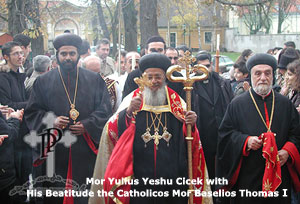 hardship for the faithful in Malankara he had visited them many times to
offer comfort and strength. His Eminence can be considered the founding father
of the
Malankara Syrian Orthodox Theological Seminary that now flourishes in Udayagiri. He
contributed about Rs. 40 lakhs--the largest contribution that made the founding
of the seminary possible in 1988. He continued to take much interest in the
growth of this institution till his end. The Church in Malankara will be
indebted to him forever.
hardship for the faithful in Malankara he had visited them many times to
offer comfort and strength. His Eminence can be considered the founding father
of the
Malankara Syrian Orthodox Theological Seminary that now flourishes in Udayagiri. He
contributed about Rs. 40 lakhs--the largest contribution that made the founding
of the seminary possible in 1988. He continued to take much interest in the
growth of this institution till his end. The Church in Malankara will be
indebted to him forever.
His Eminence maintained warm relationships with many late and current bishops of
the Church in Malankara including late
Catholicos Mor Baselios Paulose II and
the present
Catholicos H.B. Mor Baselius Thomas I.
Despite his strenuous schedule, Mor Julius always found time to stay abreast of
the struggles of the faithful in Malankara. Many from
Malankara, both clergy and laity, were warmly received by His Eminence at his
monastery in Holland. Mor Çiçek is a Syriac father that Malankara can never
forget.
Passing away
His Eminence was
only 63 when he entered into heavenly abode on October 29, 2005 in Germany.
The
late Archbishop was
later brought to the monastery of St. Ephrem the Syrian in the Dutch town of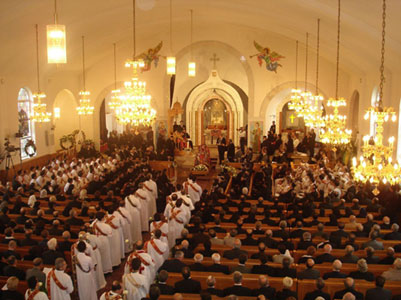 Glane, near the German border
and was kept there for public homage. Tens and thousands of faithful visited the
monastery to bid farewell to their beloved prelate.
The last rites
of the late Archbishop was held on Saturday, Nov 5, 2005. The
funeral service was led by
His Holiness Ignatius
Zakka I, the Patriarch of Antioch and the Supreme Head of the Universal
Syrian Orthodox Church.
Glane, near the German border
and was kept there for public homage. Tens and thousands of faithful visited the
monastery to bid farewell to their beloved prelate.
The last rites
of the late Archbishop was held on Saturday, Nov 5, 2005. The
funeral service was led by
His Holiness Ignatius
Zakka I, the Patriarch of Antioch and the Supreme Head of the Universal
Syrian Orthodox Church.
The mortal remains of the late Archbishop was entombed in the mausoleum below the sanctuary of the Holy Virgin Mary Cathedral in Glane, Netherlands, where also rests the late Archbishop of North America of blessed memory, Mor Athanasius Yeshue Samuel and His Grace Mor Philoxinos Ilyas Cankaya. In the untimely passing away of this great luminary, the faithful of the Syriac Orthodox Diaspora in Europe, in Malankara and all over the world have indeed lost a true shepherd.
PHOTOS OF FUNERAL
Sacred tombs of Metropolitan Mor Julius Yeshu `Çiçek, Mor Athanasius Yeshu Samuel and Mor Filuksinos Ilyas
at the Holy Virgin Mary Cathedral in Glane, Netherlands
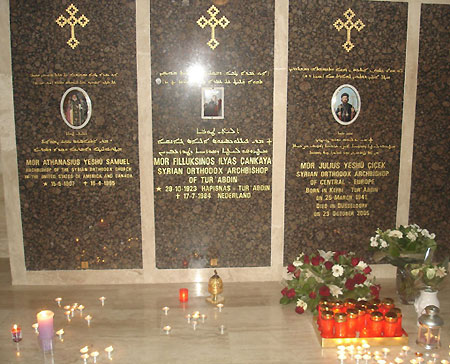 |
![]() A
video presentation on
Mor
Julius Yeshu` Çiçek
A
video presentation on
Mor
Julius Yeshu` Çiçek
Source:
1. Syriac Orthodox Resources, http://sor.cua.edu
2. Josef Aslan, http://www.Soku.org
3. SOCM forum, http://groups.yahoo.com/group/SOCM-FORUM/
4. http://www.flickr.com/photos/arnasia/
6. Video of the funeral: http://www.rtvoost.nl/mediavenster_tv.asp?id=7070&code=407&live=&special=1